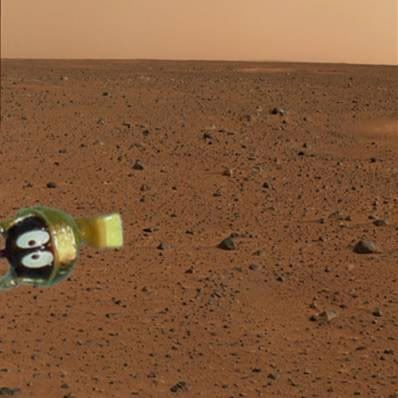| http://www.sciencebits.com/CosmicRaysClimate Cosmic Rays and Climate
By: Nir J. Shaviv
Article originally appeared in PhysicaPlus.
*** Clouds have been observed from space since the beginning of the 1980's. By the mid 1990's, enough cloud data accumulated to provide empirical evidence for a solar/cloud-cover link. Without the satellite data, it hard or probably impossible to get statistically meaningful results because of the large systematic errors plaguing ground based observations. Using the satellite data, Henrik Svensmark of the Danish National Space Center in Copenhagen has shown that cloud cover varies in sync with the variable cosmic ray flux reaching the Earth. Over the relevant time scale, the largest variations arise from the 11-yr solar cycle, and indeed, this cloud cover seemed to follow the cycle and a half of cosmic ray flux modulation. Later, Henrik Svensmark and his colleague Nigel Marsh, have shown that the correlation is primarily with low altitude cloud cover. This can be seen in fig. 3.
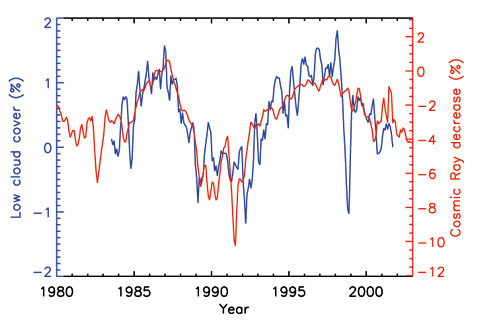
Figure 3: The correlation between cosmic ray flux (orange) as measured in Neutron count monitors in low magnetic latitudes, and the low altitude cloud cover (blue) using ISCCP satellite data set, following Marsh & Svensmark, 2003.
The solar-activity – cosmic-ray-flux – cloud-cover correlation is quite apparent. It was in fact sought for by Henrik Svensmrk, based on theoretical considerations. However, by itself it cannot be used to prove the cosmic ray climate connection. The reason is that we cannot exclude the possibility that solar activity modulates the cosmic ray flux and independently climate, without any casual link between the latter two. There is however separate proof that a casual link exists between cosmic rays and climate, and independently that cosmic rays left a fingerprint in the observed cloud cover variations.
To begin with, climate variations appear to arise also from intrinsic cosmic ray flux variations, namely, from variations that have nothing to do with solar activity modulations. This removes any doubt that the observed solar activity cloud cover correlations are coincidental or without an actual causal connection. That is to say, it removes the possibility that solar activity modulates the cosmic ray flux and independently the climate, such that we think that the cosmic rays and climate are related, where in fact they are not. Specifically, cosmic ray flux variations also arise from the varying environment around the solar system, as it journeys around the Milky Way. These variations appear to have left a paleoclimatic imprint in the geological records.
Cosmic Rays, at least at energies lower than 1015eV, are accelerated by supernova remnants. In our galaxy, most supernovae are the result of the death of massive stars. In spiral galaxies like our own, most of the star formation takes place in the spiral arms. These are waves which revolve around the galaxy at a speed different than the stars. Each time the wave passes (or is passed through), interstellar gas is shocked and forms new stars. Massive stars that end their lives with a supernova explosion, live a relatively short life of at most 30 million years, thus, they die not far form the spiral arms where they were born. As a consequence, most cosmic rays are accelerated in the vicinity of spiral arms. The solar system, however, has a much longer life span such that it periodically crosses the spiral arms of the Milky Way. Each time it does so, it should witness an elevated level of cosmic rays. In fact, the cosmic ray flux variations arising from our galactic journey are ten times larger than the cosmic ray flux variations due to solar activity modulations, at the energies responsible for the tropospheric ionization (of order 10 GeV). If the latter is responsible for a 1°K effect, spiral arm passages should be responsible for a 10°K effect—more than enough to change the state of earth from a hothouse, with temperate climates extending to the polar regions, to an icehouse, with ice-caps on its poles, as Earth is today. In fact, it is expected to be the most dominant climate driver on the 108 to 109 yr time scale.
It was shown by the author (Shaviv 2002, 2003), that these intrinsic variation in the cosmic ray flux are clearly evident in the geological paleoclimate data. To within the determinations of the period and phase of the spiral-arm climate connection, the astronomical determinations of the relative velocity agree with the geological sedimentation record for when Earth was in a hothouse or icehouse conditions. Moreover, it was found that the cosmic ray flux can be independently reconstructed using the so called "exposure ages" of Iron meteorites. The signal, was found to agree with the astronomical predictions on one hand, and correlate well with the sedimentation record, all having a ~145 Myr period.
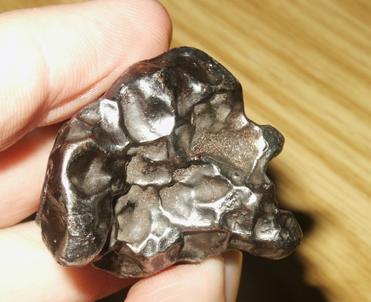
Figure 4: An Iron meteorite. A large sample of these meteorites can be used to reconstruct the past cosmic ray flux variations. The reconstructed signal reveals a 145 Myr periodicity. The one in the picture is part of the Sikhote Alin meteorite that fell over Siberia in the middle of the 20th century. The cosmic-ray exposure age of the meteorite implies that it broke off its parent body about 300 Million years ago.
In a later analysis, with Ján Veizer of the University of Ottawa and the Ruhr University of Bochum, it was found that the cosmic ray flux reconstruction agrees with a quantitative reconstruction of the tropical temperature (Shaviv & Veizer, 2003). In fact, the correlation is so well, it was shown that cosmic ray flux variations explain about two thirds of the variance in the reconstructed temperature signal. Thus, cosmic rays undoubtedly affect climate, and on geological time scales are the most dominant climate driver.
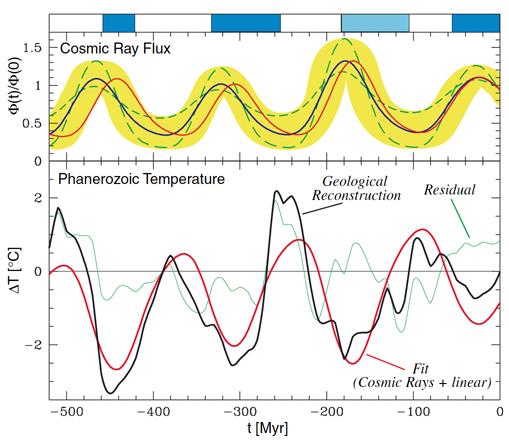
Figure 5: Correlation between the cosmic ray flux reconstruction (based on the exposure ages of Iron meteorites) and the geochemically reconstructed tropical temperature. The comparison between the two reconstructions reveals the dominant role of cosmic rays and the galactic "geography" as a climate driver over geological time scales. (Shaviv & Vezier 2003) 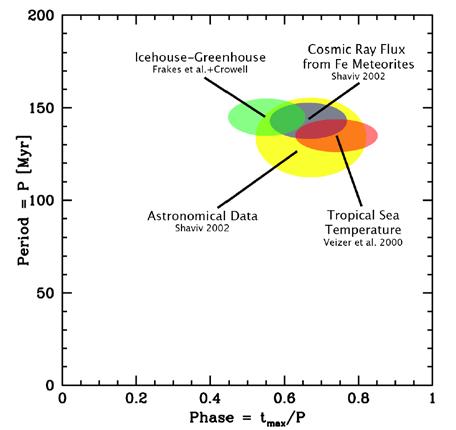
Figure 6: A summary of the 4 different signals revealing the cosmic ray flux climate link over geological time scales. Plotted are the period and phase (of expected peak coldness) of two extraterrestrial signals (astronomical determinations of the spiral arm pattern speed and cosmic ray flux reconstruction using Iron meteorites) and two paleoclimate reconstruction (based on sedimentation and geochemical records). All four signals are consistent with each other, demonstrating the robustness of the link. If any data set is excluded, a link should still exist.
Recently, it was also shown by Ilya Usoskin of the University of Oulu, Nigel Marsh of the Danish Space Research Center and their colleagues, that the variations in the amount of low altitude cloud cover follow the expectations from a cosmic-ray/cloud cover link (Usoskin et al., 2004). Specifically, it was found that the relative change in the low altitude cloud cover is proportional to the relative change in the solar-cycle induced atmospheric ionization at the given geomagnetic latitudes and at the altitude of low clouds (up to about 3 kms). Namely, at higher latitudes were the the ionization variations are about twice as large as those of low latitudes, the low altitude cloud variations are roughly twice as large as well.
Thus, it now appears that empirical evidence for a cosmic-ray/cloud-cover link is abundant. However, is there a physical mechanism to explain it? The answer is that although there are indications for how the link may arise, no firm scenario, at least one which is based on solid experimental results, is yet present.
Although above 100% saturation, the preferred phase of water is liquid, it will not be able to condense unless it has a surface to do so on. Thus, to form cloud droplets the air must have cloud condensation nuclei—small dust particles or aerosols upon which the water can condense. By changing the number density of these particles, the properties of the clouds can be varied, with more cloud condensation nuclei, the cloud droplets are more numerous but smaller, this tends to make whiter and longer living clouds. This effect was seen down stream of smoke stacks, down stream of cities, and in the oceans in the form of ship tracks in the marine cloud layer.
The suggested hypothesis, is that in regions devoid of dust (e.g., over the large ocean basins), the formation of cloud condensation nuclei takes place from the growth of small aerosol clusters, and that the formation of the latter is governed by the availability of charge, such that charged aerosol clusters are more stable and can grow while neutral clusters can more easily break apart. Several experimental results tend to support this hypothesis, but not yet prove it. For example, the group of Frank Arnold at the university of Heidelberg collected air in airborne missions and found that, as expected, charge clusters play an important role in the formation of small condensation nuclei. It is yet to be seen that the small condensation nuclei grow through accretion and not through scavenging by larger objects. If the former process is dominant, charge and therefore cosmic ray ionization would play an important role in the formation of cloud condensation nuclei.
One of the promising prospects for proving the "missing link", is the SKY experiment being conducted in the Danish National Space Center, where a real "cloud chamber" mimics the conditions in the atmosphere. This includes, for example, varying levels of background ionization and aerosols levels (sulpheric acid in particular). Within a few months, the experiment will hopefully shed light on the physical mechanics responsible for the apparent link between cloud cover and therefore climate in general, to cosmic rays, and through the solar wind, also to solar activity.
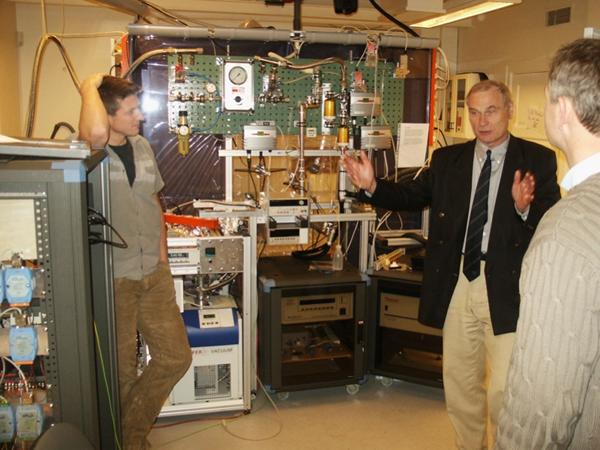
Figure 7: The Danish National Space Center SKY reaction chamber experiment. The experiment was built with the goal of pinning down the microphysics behind the cosmic ray/cloud cover link found through various empirical correlations. From left to right: Nigel Marsh, Jan Veizer, Henrik Svensmark. Behind the camera: the author. The implications of this link are far reaching. Not only does it imply that on various time scales were solar activity variations or changes in the galactic environment prominent, if not the dominent climate drivers, it offers an explanation to at least some of the climate variability witnessed over the past century and millennium. In particular, not all of the 20th century global warming should be attributed to anthropogenic sources, since increased solar activity explains through this link more than half of the warming.
More information can be found at:
- A general article on the cosmic ray climate link over geological time scales.
- Henrik Svensmark's web site, including various publications on the cosmic-ray/cloud link.
- The awaited results of the Danish SKY cloud experiment will be reported on their website within several months.
Notes and References:
* On solar activity /climate correlation:
- For the first suggestion that solar variability may be affecting climate, see: William Herschel, "Observations tending to investigate the nature of our sun, in order to find causes or symptoms of its variable emission of light and heat", Phil. Trans. Roy. Soc. London, 91, 265 (1801). Note that Herschel suspected that it is variations in the total output which may be affecting the climate (and with it the price of wheat).
- Perhaps the most beautiful correlation between a solar activity and climate proxies can be found in the work of U. Neff et al., "Strong coherence between solar variability and the monsoon in Oman between 9 and 6 kyr ago", Nature 411, 290 (2001).
- Another beautiful correlation between solar activity and climate can be seen in the work of G. Bond et al., "Persistent Solar Influence on North Atlantic Climate During the Holocene", Science, 294, 2130-2136, (2001).
* On cosmic ray and cloud cover correlation:
- The paper by Henrik Svensmark, reports the correlation between cosmic ray flux variations and cloud cover changes: H. Svensmark, "Influence of Cosmic Rays on Earth's Climate", Physical Review Letters 81, 5027 (1998).
- The specific correlation with low altitude cloud cover is discussed in N. Marsh and H. Svensmark, "Low Cloud Properties Influenced by Cosmic Rays", Physical Review Letters 85, 5004 (2000).
- Further analysis including the relative role of CRF variations vs. el-niño can be found in: N. Marsh and H. Svensmark, "Galactic cosmic ray and El Niño-Southern Oscillation trends in International Satellite Cloud Climatology Project D2 low-cloud properties", J. of Geophys. Res., 108(D6), 6 (2003).
- The analysis showing the geographic signature of the cosmic ray flux variations in the low altitude cloud cover variations can be found it: I. Usoskin et al., "Latitudinal dependence of low cloud amount on cosmic ray induced ionization", Geophysical Research Letters 31, L16109 (2004).
* On cosmic ray climate correlations on Geological time scales:
- The suggestion that cosmic ray flux variations spiral arm passages could give rise to ice-age epochs is found at: N. Shaviv, "Cosmic Ray Diffusion from the Galactic Spiral Arms, Iron Meteorites, and a Possible Climatic Connection", Physical Review Letters 89, 051102, (2002).
- A highly detailed analysis, including the cosmic ray reconstruction using iron meteorites is found in: N. Shaviv, "The spiral structure of the Milky Way, cosmic rays, and ice age epochs on Earth", New Astronomy 8, 39 (2003).
- The analysis of Shaviv & Veizer demonstrates the primary importance of comic ray flux variations over geological time scales, and with it, place a limit on climate sensitivity: N. Shaviv & J. Veizer, "A Celestial driver of Phanerozoic Climate?", GSA Today 13, No. 7, 4, 2003.
|





